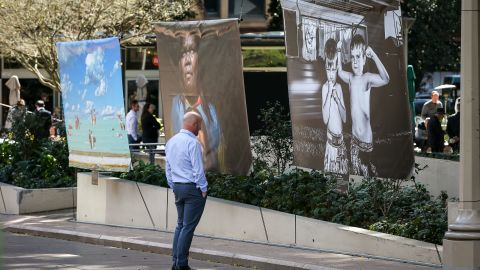We caught up with Australian Life finalists and winners. They share what they’re up to now, how the exhibition has made a difference to their work, and some tips for other photographers and entrants.
By Imogen Eveson

A Call to Prayer
“You can actually feel when you’ve got a good picture, as you’re shooting it,” said Jeremy Piper, a 2-time Australian Life finalist.
His photograph, Call to Prayer, was selected in 2015 and depicts a young girl playing on her smartphone during a Muslim men’s evening prayer in Lakemba. Seemingly oblivious to her surrounds and completely comfortable, in this split second she is a symbol of modern Australia.
As a photojournalist by trade, Jeremy spends a lot of time looking at images. But here was a scene he hadn’t witnessed before.
“So that was lucky,” he said. “I was fortunate to see that.”

Barber Shop
Jon Lewis’s winning entry in 2016 was snapped spontaneously. His striking image, Barber Shop, was just one of hundreds of street portraits that the preeminent photographer has taken over the last 3 and a half years.
“I had no idea it would win,” he said. “I can pay some bills!
“Throughout 2 decades of teaching photography, I always told my students, 'photography is not the Olympics'. However, a competition such as Australian Life is a great opportunity to support and appreciate photography – Australian photography – which contributes to our culture, and to receive wonderful feedback from the public.”
20 of his Sydney street portraits formed an exhibition at the State Library of NSW, Beauty in Difference: The Street Photography of Jon Lewis.

The Last Piece
Taweechai Iam-urairat captured the uncanny moment a seagull swoops in for a hot chip proffered from the inside of a parked car as the sun sets in La Perouse.
Being a finalist has already affected change for Iam-urairat, an emerging photographer.
“This opportunity has had a substantial impact on my life,” he explains. “People came to talk to me after the exhibition and started to follow me on social media.”
It has also given him a greater sense of purpose in his pursuit of street photography, and a resolve to take part in the competition each year.

Like a Prayer
Simone Cheung lensed Like a Prayer at the Auburn Gallipoli Mosque and made the shortlist in 2016.
“Being a self-taught, amateur photographer, making it as a finalist in Australian Life was a turning point for me,” she says. She practices photography alongside a day job in health and social policy.
“It gave me the confidence to keep pursuing what I love,” she said. “I get to combine all the things I am passionate about – photography, travel and social issues.”

The Lambs
“I think if photographers are true to themselves, are not doing it to simply stand out in the crowd and keep putting in the hard work then maybe, one day, their work will become good enough to be recognised for the right reasons,” said 2016 finalist Deb Bonney.
Her playful image, The Lambs, shows a family of sheep taking shelter from the sun on a verandah in country Victoria. “But I think as photographers we need to realise that we may not be recognised and that’s okay too, we just keep doing it because we love/need to do it.”
Tips for budding photographers
Putting in the hard work is a sentiment that Jon Lewis relates to. “Inspiration is the key … Go to the masters and study their work.”
For him, those masters include Diane Arbus, Henri Cartier-Bresson, Josef Koudelka, Sebastião Salgado and, of course, Australia’s own Max Dupain.
“This, I think, is imperative,” Lewis says, “as too much photography these days is based on technique rather than an aesthetic.”
For Piper, “it’s something that hasn’t been seen before [that stands out] these days."
And Lewis, in quoting Diane Arbus, agrees. “It’s what I’ve never seen before that I recognise.”
Published 24 July 2017, updated 4 December 2018



